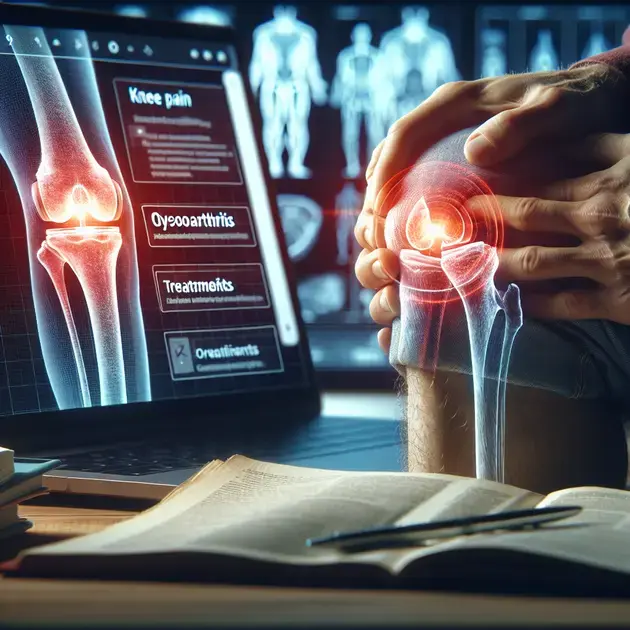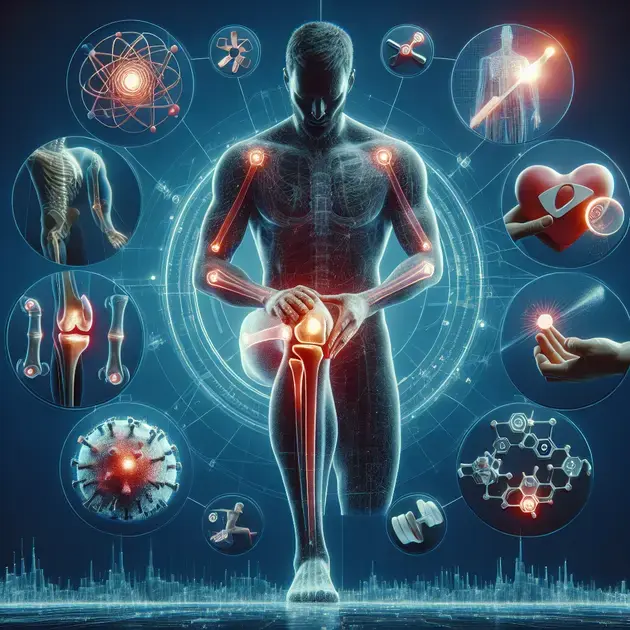Understanding Knee Osteoarthritis is crucial for both patients and healthcare providers. This degenerative joint disease affects millions of people worldwide, with an increasing prevalence due to aging populations and rising obesity rates.
Causes of Knee Osteoarthritis are diverse, ranging from genetic factors to traumatic injuries. Common symptoms include pain, stiffness, and swelling, leading to decreased mobility and quality of life. Fortunately, various treatment options, such as physical therapy, medications, and even surgery, can help manage the condition and improve patients’ overall well-being.

The Importance of Understanding Knee Osteoarthritis
Knee osteoarthritis is a common condition that affects millions of people worldwide. It is important to have a good understanding of this condition in order to manage the symptoms effectively and improve quality of life. One crucial aspect of understanding knee osteoarthritis is recognizing the risk factors associated with it. These can include age, obesity, previous joint injuries, and genetics. By knowing these risk factors, individuals can take steps to reduce their likelihood of developing knee osteoarthritis.
Another key point in understanding knee osteoarthritis is knowing the symptoms to look out for. These can include pain, swelling, stiffness, and decreased range of motion in the affected joint. Being aware of these symptoms can help individuals seek early treatment and prevent the condition from worsening. Websites such as WebMD and the Arthritis Foundation offer comprehensive information on the symptoms of knee osteoarthritis and how to recognize them.
Furthermore, understanding the impact of knee osteoarthritis on daily life is essential. This condition can limit mobility, affect work performance, and lead to overall decreased quality of life. By recognizing these effects, individuals can work with healthcare professionals to develop personalized treatment plans that address their specific needs and goals. Platforms like Healthline and Mayo Clinic provide valuable insights into the effects of knee osteoarthritis on daily life.
Education plays a crucial role in managing knee osteoarthritis effectively. By educating oneself about the condition through reputable sources and medical professionals, individuals can make informed decisions about their healthcare and take proactive steps to improve their joint health.
Diverse Causes of Knee Osteoarthritis
There are various causes of knee osteoarthritis, ranging from genetic factors to lifestyle choices. One common cause is aging, as wear and tear on the joints over time can lead to the development of osteoarthritis. Understanding how age impacts the risk of knee osteoarthritis can help individuals take preventive measures early on. Resources like the Centers for Disease Control and Prevention (CDC) offer insights into how age can influence the development of osteoarthritis.
Obesity is another significant cause of knee osteoarthritis. Excess weight puts extra pressure on the joints, leading to increased wear and tear over time. By maintaining a healthy weight through diet and exercise, individuals can reduce their risk of developing osteoarthritis in the knees. Websites such as the National Institute of Arthritis and Musculoskeletal and Skin Diseases provide information on the link between obesity and knee osteoarthritis.
Joint injuries, whether from sports, accidents, or repetitive strain, can also contribute to the development of knee osteoarthritis. Understanding how these injuries can lead to osteoarthritis can help individuals take precautions to protect their joint health. Platforms like OrthoInfo and Verywell Health offer guidance on preventing joint injuries and minimizing the risk of osteoarthritis.
In addition to these causes, genetics can also play a role in predisposing individuals to knee osteoarthritis. By understanding the genetic factors that contribute to this condition, individuals can work with healthcare providers to develop personalized treatment plans that address their unique genetic risk factors. Genetic testing services like 23andMe provide insights into the role of genetics in osteoarthritis.
Effective Treatment Options for Knee Osteoarthritis
When it comes to treating knee osteoarthritis, there are various options available to help manage symptoms and improve joint function. One commonly recommended treatment is physical therapy, which focuses on strengthening the muscles around the knee joint, improving flexibility, and reducing pain. By working with a physical therapist, individuals can learn specific exercises and techniques to support their knee health. Platforms like Physiopedia and MoveForwardPT offer resources on physical therapy for knee osteoarthritis.
Medications, such as nonsteroidal anti-inflammatory drugs (NSAIDs) and pain relievers, can also be used to alleviate pain and inflammation associated with knee osteoarthritis. Understanding the different types of medications available, their benefits, and potential side effects is important for making informed treatment decisions. Websites like RxList and Drugs.com provide information on various medications for knee osteoarthritis.
In cases where conservative treatments are ineffective, surgical options like knee replacement surgery may be considered. Understanding the process of knee replacement surgery, including the risks, benefits, and recovery period, is essential for individuals considering this treatment option. Websites such as the American Academy of Orthopaedic Surgeons (AAOS) and Healthgrades offer detailed information on knee replacement surgery.
Complementary therapies, such as acupuncture, massage, and supplements, can also play a role in managing knee osteoarthritis symptoms. By exploring these alternative treatment options in conjunction with traditional medical approaches, individuals can tailor their treatment plan to their specific needs and preferences. Resources like the National Center for Complementary and Integrative Health (NCCIH) provide insights into complementary therapies for osteoarthritis.

Common Symptoms of Knee Osteoarthritis
When it comes to knee osteoarthritis, there are several common symptoms that individuals may experience. One of the primary indications of knee osteoarthritis is pain, which can range from mild discomfort to severe aching that limits movement. Stiffness in the knee joint, especially after periods of inactivity or rest, is another prevalent symptom. Swelling and tenderness around the knee area are also commonly reported by those with knee osteoarthritis.
Some individuals with knee osteoarthritis may notice a decrease in flexibility and range of motion in the affected knee. This can make activities like bending, kneeling, or climbing stairs more challenging. In some cases, a grating sensation or the feeling of bone rubbing against bone may occur within the knee joint. As knee osteoarthritis progresses, these symptoms can worsen and have a significant impact on daily life.
To diagnose knee osteoarthritis, a healthcare provider may perform a physical examination, review the individual’s medical history, and possibly order imaging tests such as X-rays or MRIs. It’s essential for individuals experiencing these symptoms to seek medical attention for an accurate diagnosis and appropriate management.
Managing Pain in Knee Osteoarthritis
Effectively managing pain is a crucial aspect of dealing with knee osteoarthritis. One common method for pain relief is the use of over-the-counter nonsteroidal anti-inflammatory drugs (NSAIDs) such as ibuprofen or naproxen. These medications can help reduce pain and inflammation in the knee joint. In some cases, prescription pain medications or injections may be recommended for more severe pain.
Physical therapy exercises tailored to strengthen the muscles around the knee joint can also help alleviate pain and improve mobility. These exercises can improve flexibility, reduce stiffness, and enhance overall joint function. Using assistive devices such as canes or braces can provide additional support and aid in pain management during daily activities.
Other non-pharmacological approaches to managing pain in knee osteoarthritis include hot or cold therapy, acupuncture, and weight management. Maintaining a healthy weight can reduce stress on the knee joint and decrease pain levels. Practicing mindfulness techniques or engaging in activities that promote relaxation can also help individuals cope with chronic pain.
Preventive Measures for Knee Osteoarthritis
While knee osteoarthritis can be challenging to prevent entirely, there are steps individuals can take to reduce their risk of developing the condition. Engaging in regular physical activity that includes low-impact exercises like swimming or cycling can help maintain joint health and flexibility. Strengthening the muscles around the knee through targeted exercises can provide added support and stability.
Adopting a healthy diet rich in anti-inflammatory foods such as fruits, vegetables, and omega-3 fatty acids can help reduce inflammation in the body and support joint health. Avoiding excessive stress on the knees by using proper lifting techniques and wearing supportive footwear can also prevent unnecessary strain on the joint.
Regularly attending routine check-ups with a healthcare provider can help monitor for any early signs of knee osteoarthritis and address them promptly. By practicing preventive measures and maintaining an overall healthy lifestyle, individuals can potentially reduce their risk of developing knee osteoarthritis and minimize its impact on their daily functioning.
Conclusion
In conclusion, understanding the common symptoms of knee osteoarthritis is crucial in early detection and management. From persistent pain and stiffness to decreased flexibility and grating sensations, recognizing these indicators can lead to timely medical intervention and appropriate care. Individuals experiencing these symptoms should promptly seek professional diagnosis and treatment to mitigate the impact of knee osteoarthritis on their quality of life.
Additionally, effective pain management strategies play a pivotal role in alleviating discomfort associated with knee osteoarthritis. Whether through the use of NSAIDs, physical therapy, or non-pharmacological approaches like hot/cold therapy and weight management, addressing pain can enhance mobility and joint function. By incorporating these methods into daily routines, individuals can better cope with the challenges posed by knee osteoarthritis.
Furthermore, adopting preventive measures such as engaging in regular exercise, maintaining a balanced diet, and attending routine check-ups can significantly reduce the risk of developing knee osteoarthritis. By proactively strengthening muscles, reducing inflammation, and avoiding excessive strain on the knees, individuals can safeguard their joint health and overall well-being. Taking proactive steps towards prevention can help individuals lead healthier, more active lives free from the constraints of knee osteoarthritis.